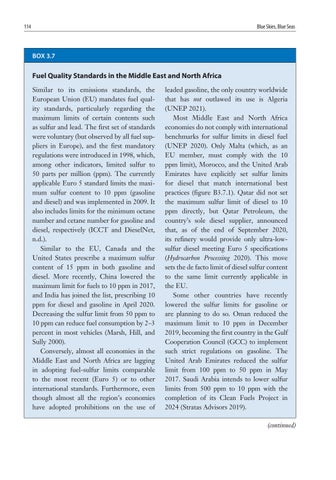114
Blue Skies, Blue Seas
BOX 3.7
Fuel Quality Standards in the Middle East and North Africa Similar to its emissions standards, the European Union (EU) mandates fuel quality standards, particularly regarding the maximum limits of certain contents such as sulfur and lead. The first set of standards were voluntary (but observed by all fuel suppliers in Europe), and the first mandatory regulations were introduced in 1998, which, among other indicators, limited sulfur to 50 parts per million (ppm). The currently applicable Euro 5 standard limits the maximum sulfur content to 10 ppm (gasoline and diesel) and was implemented in 2009. It also includes limits for the minimum octane number and cetane number for gasoline and diesel, respectively (ICCT and DieselNet, n.d.). Similar to the EU, Canada and the United States prescribe a maximum sulfur content of 15 ppm in both gasoline and diesel. More recently, China lowered the maximum limit for fuels to 10 ppm in 2017, and India has joined the list, prescribing 10 ppm for diesel and gasoline in April 2020. Decreasing the sulfur limit from 50 ppm to 10 ppm can reduce fuel consumption by 2–3 percent in most vehicles (Marsh, Hill, and Sully 2000). Conversely, almost all economies in the Middle East and North Africa are lagging in adopting fuel-sulfur limits comparable to the most recent (Euro 5) or to other international standards. Furthermore, even though almost all the region’s economies have adopted prohibitions on the use of
leaded gasoline, the only country worldwide that has not outlawed its use is Algeria (UNEP 2021). Most Middle East and North Africa economies do not comply with international benchmarks for sulfur limits in diesel fuel (UNEP 2020). Only Malta (which, as an EU member, must comply with the 10 ppm limit), Morocco, and the United Arab Emirates have explicitly set sulfur limits for diesel that match international best practices (figure B3.7.1). Qatar did not set the maximum sulfur limit of diesel to 10 ppm directly, but Qatar Petroleum, the country’s sole diesel supplier, announced that, as of the end of September 2020, its refinery would provide only ultra-lowsulfur diesel meeting Euro 5 specifications (Hydrocarbon Processing 2020). This move sets the de facto limit of diesel sulfur content to the same limit currently applicable in the EU. Some other countries have recently lowered the sulfur limits for gasoline or are planning to do so. Oman reduced the maximum limit to 10 ppm in December 2019, becoming the first country in the Gulf Cooperation Council (GCC) to implement such strict regulations on gasoline. The United Arab Emirates reduced the sulfur limit from 100 ppm to 50 ppm in May 2017. Saudi Arabia intends to lower sulfur limits from 500 ppm to 10 ppm with the completion of its Clean Fuels Project in 2024 (Stratas Advisors 2019). (continued)
